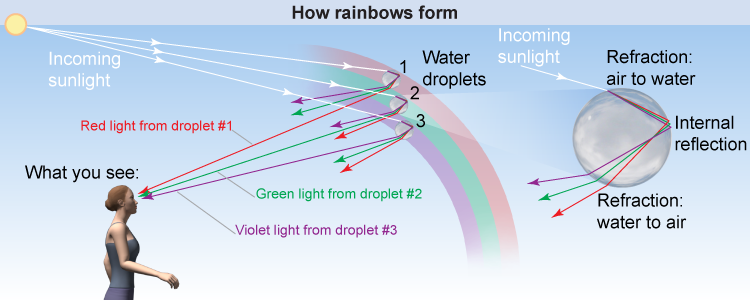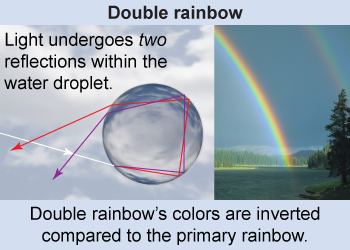|
A rainbow is caused by the same physical phenomenon that is behind the prism: the dispersion of light. In dispersion, white light is separated into its constituent colors, from red to green to violet. 
|

|
You can only see a rainbow when you are facing away from the Sun and looking relatively low toward the horizon at air that is humid—full of water droplets. But what causes the effect of the rainbow? The water droplets disperse the white sunlight, refracting the red light rays less than violet light rays. The refraction occurs at the interface between air (n = 1) and water (n = 1.33). Inside the water droplets, the light rays also reflect internally, because the rays strike the inside back surface of the droplet at an incidence angle greater than the critical angle. The violet light rays emerging from the water droplet travel closer to parallel with the ground; the emerging red light rays travel more directly toward the ground. 
 |

| In the illustration above, red and violet light rays appear to emerge along paths that make a significant angle with each other. The illustration is not to scale, however! If you used a protractor to measure the angle between the red and violet light that reaches your eyes, you would find them to differ by only 2°! The red light in sunlight is reflected back at an angle of 42° with respect to the incident light, while violet light is reflected back at an angle of 40°. That is why a rainbow appears relatively thin in the distance—the thickness of the rainbow only spans a 2° angle. |

|
The rainbow is created because your eyes are seeing light rays of different colors coming from different water droplets—either higher or lower in the sky. The red light in a rainbow comes to your eyes from the highest water droplets, because the droplets have refracted the red light by the least angle. Violet light in the rainbow comes from the lowest water droplets, because the violet light rays were bent the most by refraction. That is why red is always on top of a rainbow; violet is at the bottom. 
|
 The same water droplets that produce a rainbow can also produce a second rainbow—higher in the sky than the primary rainbow—called a double rainbow. A double rainbow is produced when sunlight inside the water droplets undergoes two internal reflections, not one. Because there are two internal reflections, the relative directions of the colors in a double rainbow are inverted with respect to the primary rainbow; i.e., the double rainbow has red at the bottom while the primary rainbow has red at the top. A double rainbow is much fainter than the primary rainbow because of the added losses resulting from the additional reflection.
The same water droplets that produce a rainbow can also produce a second rainbow—higher in the sky than the primary rainbow—called a double rainbow. A double rainbow is produced when sunlight inside the water droplets undergoes two internal reflections, not one. Because there are two internal reflections, the relative directions of the colors in a double rainbow are inverted with respect to the primary rainbow; i.e., the double rainbow has red at the bottom while the primary rainbow has red at the top. A double rainbow is much fainter than the primary rainbow because of the added losses resulting from the additional reflection. 
|
Does violet light or red light travel faster in glass?
 |
Red light travels faster in glass. Violet light has a higher index and is refracted more in glass; this means that its motion is impeded more and it is moving slower in the glass. 
|

